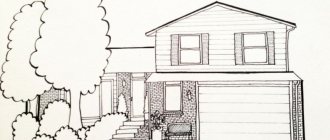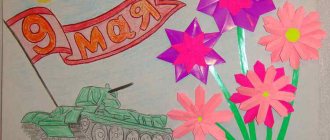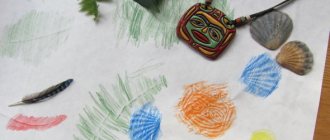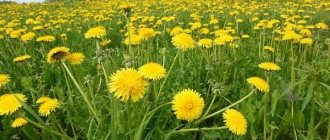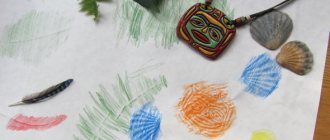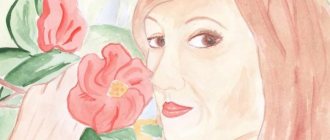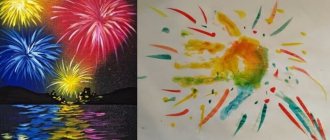What do you need for drawing?
The list of necessary tools and materials for drawing can be viewed in the table.
| Simple pencils | You need 3 pencils of different degrees of hardness: hard, soft, hard-soft. |
| Sharpener | You need to draw thin and graceful lines with sharply sharpened pencils. |
| Eraser | It is advisable to purchase a double-sided eraser with a soft and rough end to effectively remove pencil lines of different thicknesses. |
| Helium pens | They may be needed to work out small details and perform final strokes. |
| Artistic brushes | To paint plants, you need thin brushes with soft bristles, as well as medium-thick brushes with short, stiff bristles. |
You can color the drawing with paints, colored pencils, pens or felt-tip pens.
What colors do artists use to paint dandelions:
- dark green;
- light green;
- yellow;
- orange;
- white;
- grey;
- brown.
Paints have different textures, so they will look different on paper. For example, a watercolor drawing will turn out gentle, without rough lines and bright shades. The colors will merge and smoothly transition from one to another. Gouache is a brighter and thicker paint, but when it dries it becomes lighter by 2 tones.
To get rich shades, the picture is painted in 2 layers.
Description and features
Dandelion belongs to the Asteraceae family and is a herbaceous perennial. The scientific name of its species is dandelion officinalis , pharmaceutical or ordinary. In Russia, almost two hundred species of dandelions are known in nature, about a hundred of them are considered medicinal.
The sound in Russian of “dandelion” is the same root word from the verb “to blow”: due to the slight movement of air, parachute seeds are torn from the basket and moved to a new place.
Each dandelion seed is a dry achene fruit attached to a thin rod with a parachute. Once in the ground, they immediately begin to germinate.
The dandelion root has a tap-like appearance with branches; it is relatively thick, reaching up to 50 cm deep into the soil. There are rings of milky passages on it; they can be seen under a magnifying glass.
Dandelion leaves come out of the rosette. Each pinnately dissected leaf blade has a groove in the middle to collect moisture. If the dandelion lives in a comfortable place, the leaves grow up to 40-50 cm; on dry soil - no more than 20 cm.
An arrow shoots out of the rosette - it is a tubular hollow stem with an inflorescence at the end. A dandelion flower is not just one flower, but a whole basket of bright tubular flowers with fused petals and stamens.
Dandelion is a unique natural barometer and clock. In the afternoon, at 3 p.m., or in humid weather, before rain, the “barometer” baskets are hidden, protecting the pollen from moisture. At 6 am and clear weather they open their yellow heads again.
The healing properties of dandelion are beyond doubt. It is contraindicated only in cases of acute blockage in the bile ducts, with increased levels of hydrochloric acid and with chronic problems in the gastrointestinal tract. Signs that you need to pay attention to and stop taking it: vomiting and diarrhea.
Step-by-step instructions for drawing a dandelion with a pencil
The dandelion (the drawing for children over 10 years old should be detailed) should be drawn with sharply sharpened pencils so that the lines are thin and graceful. The picture shows 2 stages of flower development at once: a bud and an inflorescence with seeds. You also need to draw a plant leaf with large teeth.
Sketch
Drawing should begin by marking the contours of the flower. For this you need a hard pencil.
Procedure:
- Draw 1 vertical line from the center of the sheet from bottom to top. It should not be straight, as if drawn with a ruler. On the contrary, you need to make it smooth, slightly curving. This is the base of the dandelion stem. These flowers do not grow straight. Their stems bend from the weight of the inflorescences and take on a curved shape.
- Draw 1 more line nearby. This will be the 2nd stem for another inflorescence. It can be drawn shorter or longer than the first one. It is important that the stems at the bottom come out from 1 point, and at the top they diverge in different directions. The distance between their pinwheels should be such that the flowers drawn next do not intersect with each other.
- Draw a 3rd line on the opposite side. It should be a little shorter than the previous 2. Its top needs to be taken away from others.
- The last line drawn is the middle of the dandelion leaf. Now you need to give it a shape, marking wide teeth on both sides, as well as a sharp top.
- Above 1 line indicate the shape of a fluffy hat with seeds. This should be done with thin, intermittent strokes.
- Above the 2nd line draw the shape of an unopened bud.
A sketch helps to maintain the correct proportions and correctly position all the small details in the drawing. When creating a sketch, you should not put pressure on the pencil. The lead should barely touch the paper and leave almost imperceptible marks.
When all the details are drawn in the picture, the lines made with a hard pencil will need to be erased. If the sketch is rich and clear, it will be difficult to remove it. The result will be a messy drawing.
Detailing
All details must be drawn with a hard-soft pencil.
Procedure:
- Next to each line that imitates the shape of the stem, you need to draw 1 more parallel line. It is important that it follows all the curves. The distance between these lines should be small. They are needed to make the flower stem voluminous.
- Draw sepals on the tops of the stems. They don't have to be straight either. Let the petals bend and twist in different directions. There should be 3-4 petals on 1 sepal.
- Where the shape of the bud is indicated, you need to draw folded leaves, and at the top the protruding ends of the petals.
- There will be a cap with seeds above the 2nd stem, so first you need to draw the core of the flower. It is oval in shape and protrudes above the surface of the sepals.
- Now from this core you need to draw many small lines of different sizes. They should stick out in different directions.
- Using a hard pencil, draw fluff to the top of each line.
- Above the fluffy hat you can depict flying seeds that have calved from the flower. First, draw a line, add fluff on top, and draw an elongated seed below using a soft pencil. The seeds should fly in different directions.
- Draw veins on the leaf of the flower.
The connection of the stems below can be covered with painted grass. Remove all extra lines with an eraser.
Hatching
To make the drawing look three-dimensional, you need to depict shadows. They are applied with strokes using a soft pencil.
Procedure:
- Shade the area under the flower.
- Apply horizontal strokes to 1 side of the stem.
- Mark the shadow under the sepals.
- Darken the middle of the sheet.
Gently rub all the strokes with your fingers. To shade the pencil inside the stem, you can use a cotton swab.
Myths about dandelion
Otduvanochka
A long time ago, on the banks of the Big River there was a small village. At its very edge stood a tiny tower. A sweet girl lived in that little house. She tended a goat and sold milk. In a green dress and a golden-yellow scarf, she went around the houses with a wooden milk bowl and poured milk into a jug for everyone who wanted it.
The girl looked like a good fairy. Cheerful and smiling, she found a kind word for everyone, and brought good news to everyone: she wished health to the sick, reconciled quarreling spouses, and predicted a quick and happy marriage for the girls.
Therefore, she was eagerly awaited everywhere, her friendly smile brought sun and spring even in the darkest weather. People nicknamed her Otduvanochka, as she “blowed away” and drove away heavy thoughts and bad moods.
The nickname sounded with warmth and kindness, and this did not offend the girl at all. Years passed, and the girl grew up, and passionately fell in love with the Lark, for his song without words. This song moved her to the core. The whole world began to sound like the song of the Lark for the girl.
Will the goat shake her head, will the bell ring on her neck, and the girl will already run to see if the Lark is flying over the run... Will the oriole whistle on the old linden tree, and Otduvanochka will immediately rush to this call, thinking that the Lark is waiting for her.. And at night she dreamed of his song.
Happiness filled the girl's heart. But it didn't last long. She wanted to know the words of the Lark's song. He descended to her from the skies and sang: “My love for you is tender, like the first ray of the sun, but the space of heaven beckons upward, and its call is powerful.”
The girl was seized by the desire to immediately hold her beloved, to leave him next to her forever. And she rushed to him, begging for this. But, a free bird, the Lark, soared into the sky and flew away. Only now Otduvanochka realized that, having wanted to deprive Lark of freedom, she had lost his love. In desperation, she waved her scarf, and several gold coins fell out of it. And the golden ones flew, spinning in a strong wind from the Big River.
The wind raged for a long time and carried gold coins all over the world. Where they fell, many golden flowers appeared in the spring, which people have since simply called dandelions. And the Lark is still circling above them, and sings his song without words...
Another belief
Since ancient times, dandelion has been the most favorite flower. He gave nectar to the bees, girls put flowers on their wreaths, the roots healed the sick, and at night golden flowers illuminated the way for the traveler. But one day the sky frowned, and evil riders appeared in the steppe, causing fires and destruction everywhere.
The dandelion hid its petals, bowed its head, and shrank, not wanting to serve evil people. Centuries passed, the black tribe disappeared, but the dandelion did not forget anything. In clear weather it brings joy, but as soon as a cloud appears, it closes its petals, warning of bad weather.
Belarusian legend
One day, in Grandma Ganuli’s yard, five chickens clucked at once. And Gagulya decided that in order to hatch all the chickens, one hen would be enough. I chose the pestle Peacock and placed 21 eggs under it.
When the time came, and to Ganula’s delight, the fluffy chickens hatched, so cute and cheerful, they ran around the house, pecking at everything. Soon she let Peacock and the chickens out into the yard to peck some grass in the sun and dig in the sand.
And so that the Chicken would not run away anywhere, she tied her leg to a branch. But that was not the case. As soon as Ganula hid in the hut, Peacock twitched, broke the rope, and flew over the fence, and after her, the chickens crawled through the holes in the fence. And at the edge of the village, in the meadow, a black kite waylaid them.
When Peacock noticed the predator, she cackled anxiously, and the kids understood her danger signal, ran in different directions, and hid in the grass. Peacock herself threw herself at the kite in despair.
When Ganulya realized it, it was already too late. She searched for a long time, and when she saw colorful feathers on the grass, she immediately understood what had happened to Peacock. I started looking for chickens, but didn’t find a single yellow feather. I just noticed bright yellow flowers among the grass. Having counted 21 flowers in them, Ganulya realized that it was her chickens that had turned into them. Since then, these flowers have turned yellow among the grasses throughout the area.
Ukrainian legend “Kulbaba”
There lived a guy Kul in the Carpathians. All the girls looked at him, but he did not pay attention to them, because he fell madly in love with a beauty named Zvonka. She lived with an old widow woman, on the highest mountain in Kosovo. After the death of her husband, she lived alone.
Once she went to the bazaar in Kosovo, saw an orphan girl there and took her in. I bought her sweets, clothes, and called her Zvonka. So the two of us lived together. Zvonka grew like a red dawn, like a slender spruce. Every Sunday, Baba and Zvonka dressed in their best clothes and went down from the mountains to Kosovo to the market. They walked for a long time, because the woman loved to listen to people say after them: “There is no more beautiful girl in the mountains than this woman’s daughter.”
At that bazaar, Kul sold viburnum pipes that he made himself. He saw Zvonka and his heart sank. The next day he took the best pipe and went to Zvonka’s house. He stood right next to the spruce tree and started playing, and that’s how they met and fell in love. The woman found out about this and forbade the girl to meet the guy. It used to be that Kul would come and begin to play for his beloved, and from behind the spruce he would hear a girl’s voice: “Oh, quieter, play quieter.”
The woman ordered me to forget you, but I don’t want to, because I love you.” The woman heard that conversation and got angry. She grabbed her beech stick and, swearing, began throwing it at the guy. In the place where the stick fell, golden flowers appeared.
The woman ran for a long time through the meadows, clearings, gardens, and roads beyond Kul. And yellow flowers remained everywhere. And Zvonka cried bitterly and kept asking: “Don’t touch me! This is my Kul, grandma!” Since then, people have called these flowers “kulbaba” (synonym: shar-baba, boy-baba).
Siberian legend
A girl was walking through the forest. I saw a hut. I came in. It’s dark in the hut, and someone is moaning. "Who is there? Answer me!” - the girl says and hears a voice: “Light the torch. You'll see!" A beautiful maiden shone a torch, crossed herself at the icon and saw an old woman lying on the stove, crying.
“Thank you for coming to see me,” says the old woman. “The Lord sent you so that I would not die and take the wisdom of life with me.” Brush away the cobwebs, light the stove, bring some water, give me something to drink. Near the fence there is a grass with a golden head, put the leaves in the water and feed me. Boil the roots twice and give them to me. My chest pain will go away, my heart will calm down. Apply the juice to your feet and drive away the swelling.”
The beautiful girl did everything as the old woman ordered: she gave her a decoction of roots to drink, leaves soaked in water, and smeared the juice on her swollen legs. And the old woman came to life, cheered up and punished, so that not only the girl herself would remember about this miraculous herb, but also tell others about it. Since then, in many villages, dandelion began to be called “grandmother’s grass.”
Dandelion value
100 grams of young and fresh dandelion leaves contain 45 kcal. The nutritional value of 100 grams of fresh product includes the following components:
- proteins – 2.7 g;
- fats – 0.7 g;
- carbohydrates – 5.7 g;
- dietary fiber – 3.5 g;
- ash – 1.8 g;
- water – 85.6 g;
- mono- and disaccharides – 0.71 g;
- saturated fatty acids – 0.17 g.
Chemical composition
The chemical composition of dandelion contains the following components:
• vitamins: β-carotene – 5.854 mg, A (RE) – 508 mcg, B1 (thiamine) – 0.19 mg, B2 (riboflavin) – 0.26 mg, B3 (pantothenic) – 0.084 mg, B6 (pyridoxine) – 0.251 mg, B9 (folic) – 27 mcg, C – 35 mg, E (TE) – 3.44 mg, K (phylloquinone) – 778.4 mcg, PP (niacin equivalent) – 0.806 mg; choline – 35.3 mg;
• macroelements: calcium – 187 mg, magnesium – 36 mg, sodium – 76 mg, potassium – 397 mg, phosphorus – 66 mg,
• trace elements: iron – 3.1 mg, zinc – 0.41 mg, copper – 171 mcg, manganese – 0.342 mg, selenium – 0.5 mcg.
Dandelion juice contains several percent rubbery substances; the roots contain triterpene compounds, sterols, carbohydrates, and fatty oil. Flowers and leaves are rich in lutein.
Read also: Birdweed: use in medicine and cooking.
Step-by-step instructions for painting a dandelion with paints
A dandelion (a drawing for young children should be simple to execute) can be painted. To depict flowers with fluffy seed caps, it is better to use colored paper, since light paint will be difficult to see on ordinary white sheets.
In this master class, a sheet of blue cardboard was used as a background; the drawing was made in gouache.
Sketch
You need to make a sketch with a hard pencil.
Algorithm of actions:
- 1 thin line to indicate the shape of the stem.
- Draw a circle at the top of the stem. This will be the core of the flower.
- Use short strokes to outline the shape of the seed cap.
- Draw a leaf of a plant.
At this stage there is no need to erase extra lines.
Detailing
Details are drawn with a hard-soft pencil.
Procedure:
- Draw veins on the leaf.
- Add volume to the stem by drawing a parallel next to the intended line.
- Draw the sepals in the form of straight and thick lines.
- Draw small lines from the core of the circle. Draw fluff on top.
- Next to the flower, draw flying seeds with fluff. Let some of them fly, and the other part lie under the flower.
All lines should be thin to make them easier to cover with paint.
Coloring
You will need thin to medium thick brushes.
Procedure:
- Using a medium-thick brush, pick up light green paint and paint over the leaf.
- Paint the stem with dark green color.
- Paint the core of the dandelion with brown paint.
- Wait until the paints dry.
- Take a thin brush, dip it in a dark green color, and draw the veins on the leaf, and also outline it with a zigzag line.
- Circle the sepal.
- Wash the brush, pick up a light green color, and apply a few short strokes along the entire length of the stem on one side.
- Wash the brush thoroughly. Take white paint and circle all the “parachutes” on the seed cap.
- Circle all the flying seeds.
When the white paint has dried, you need to moisten the brush in brown gouache and paint elongated seeds on each individual “parachute”.
Dandelion in Rus'
In Rus', popular names for medicinal dandelion: milkman (Vladimir region), milkman (Arkhangelsk, Vologda regions), duan, odui bald (Tambov region), tooth root (Kirov region), babka (Ukraine).
Common names: oduy-bald, priest's bald, puff, milkman, milkman, roadside, empty, Russian chicory, Jewish hat; Ukrainian more significant - kulbaba.
In the 15th century there was a “Trevnik of Trotsky governor Stanislav Gazhovtov”. This manuscript contains references to the dandelion "Taraxacum Deus Leonis". The following names for dandelion are also mentioned: “rastrom porchinom”, “pork’s snout”, “pork’s pucker”.
M.V. Rytov (1918) gives the following names for dandelion: “grandmother, gredunitsa (Kostr.), milker, milkbox (Vlad., due to the similarity of the receptacle with the milk strainer), lion’s tooth (from the farm. Dens leonis and the German. Lowenzahn ), kiochki (Kursk), popova baldness (Tversk, Vyat. from the Polish drink glovka), ox eyes, wolf tooth, pig mlec (Polish) "About the name of dandelion (Taraxacum)
M.V. Rytov writes that it comes “from taraxis - the name doctors of the Middle Ages used for eye disease, which they used this plant; This is where the Russian expression “goggle” comes from. Others derive the name from tarassein - to soothe, which refers to diseases subsided by a laxative."
By the way, there is still no consensus on the origin of the name Taraxacum, which, in addition to the early source indicated above, is also found in the works of Fuchs and Gesner, botanists of the 16th century. There is a version that it comes from the Arabic word tarachacum - the name of one of the types of chicory, there is another that the name comes from the Greek word tarache - excitement.
In A. P. Rogov’s “A Brief Guide to Medicinal Plants” (1944), you can find the following names for dandelion: “bagels, duan, blow-pleshka, milkweed, zhidovki, zubnik, tooth grass, tooth root, Kamchadalka, paws, letuchki, yellow-flowered plantain, hollow grass, pop, popovo gumentse, teremok, halim, hasim's grass, grass grass, wild cichor, cap."
In popular dialects, dandelion has received apt and poetic nicknames. In many places in Rus' it was called poynichek, roadside and hollow grass. The Russian names furry hat and Jewish hat are associated with the property of a flower to become overgrown with a fluffy cap. But where does the “pleshevets” come from?
It turns out that it comes from a bare, pitted receptacle: you blow off the fluff and suddenly it appears like a bald spot. That's what they said: "You're bald." That is why in the Middle Ages the dandelion was called Capuy monachi - “monk’s head”.
Another group of names is due to the milky sap contained in all parts of the plant. This is what they say about him: It is the cow, not the nightingale, that flies with milk. In Rus', dandelion was also called the “elixir of life.”
The word “dandelion” is of Moscow origin, the verbal basis is to blow or blow. It took root as the main one, although very similar forms were also known: dandelion, dandelion, pustule, wind blower.
The medicinal or common variety of the plant is sometimes called Russian chicory in some places. The most famous species of the Dandelion genus of the Asteraceae family. Common names: kulbaba, spurge, pustodui, Jewish hat, tooth root, cotton grass, Russian chicory. Dandelion is widely popular in folk medicine, cosmetology, and cooking.
Dandelion has long been used as food by various peoples; it was consumed by both the ancient Chinese and the first settlers on the American continent. In Western European countries, dandelion has found use as a medicinal and food plant.
It is specially cultivated in France, Spain, Switzerland, Portugal, Japan, India, and the USA, where young leaves and ovaries are used as a delicious vitamin salad, eagerly consumed by the local population.
Dandelion is widely popular in the Caucasus, where it is traditionally used for cooking. In the British Isles, a very pleasant wine, popular in England, has been produced from dandelion flowers for a long time.
This wine was sung by R. Bradbury in his story “Dandelion Wine,” where this very real fact for the British was used. Dandelion has the following names in other languages:
- in German – Butterblume, Kuhblume, Pusteblume, Wilde Zichorie;
- in English – dandelion;
- in French – dent de lion, pissenlit.
Examples of images for sketching, tips for beginners
To draw a neat and beautiful picture, you need to know a few secrets:
- It is more convenient for younger children to draw on A3 paper. It is difficult for them to draw small details, especially with their fingers. These sheets have more space than standard album pages.
- If you don't have a white pen or white paint on hand, you can replace them with a proofreader.
- To prevent a sheet of paper from moving around on the table, it can be secured with small pieces of tape in the corners.
- In schematic drawings, it is not necessary to draw each dandelion “parachute” separately. Instead, you can wet the brush with white paint and, holding it over the paper, move it with your fingers. Small dots will imitate flying seeds.
Drawing dandelions will help children develop fine motor skills, as well as expand their knowledge about these plants. Parents should engage with their children and comment on the drawing process to maintain the child's interest.
It is necessary to explain what the different parts of the plant are called, how the seeds spread, and why dandelions come in 2 colors. You can choose a picture for sketching from the options presented in the article.
Beneficial properties of dandelion
Dandelion has the following beneficial properties:
- contains a huge amount of minerals valuable for the human body;
- relieves swelling;
- helps relieve redness and itching after insect bites;
- used for weight loss;
- enhances lactation;
- actively fights toxins;
- improves metabolism;
- helps whiten skin.
Harm
In some cases, dandelion can help:
- blockage of the biliary tract;
- exacerbation of ulcers or gastritis;
- diarrhea;
- vomiting.
Contraindications
It is not recommended to use dandelion as food or medicine in the following cases:
- if there are problems with the biliary tract;
- in the presence of acute stomach diseases;
- if you have a pollen allergy.
How did our ancestors use it?
1. Oil. Dandelion oil is obtained by mixing crushed dandelion root with vegetable or olive oil. There should be 25 g of oil per 100 g of roots. You need to infuse it for a couple of weeks in a warm room. Dandelion oil is used as an ointment or compress against burns, as well as in the presence of bites, eczema and other inflammations of the skin.
Read also: Oil potions in Rus'.
2. The juice of the plant strengthens and tones the body. It helps restore the acid-base balance in it. It is obtained from all parts of the dandelion. To do this, they are crushed and slightly diluted with water. However, before this, the dandelions are soaked for half an hour in cool water, which is pre-salted so that it does not taste so bitter. Canning juice in alcohol is allowed. In combination with the juices of carrots and turnip leaves, dandelion juice helps strengthen bones, spine and teeth. Dandelion kvass was prepared from the juice, fermented with rye breadcrumbs or oats, adding raisins and honey.
3. In Strava (culinary) to prepare puree, as an additive to cabbage soup, soups, borscht, salads, summer vinaigrettes, jam was made from flowers, leaves were dried for seasoning, pickled and fermented, and boiled leaves were replaced in Rus' by spinach. Dandelion wine was also made from buds, flowers and stems.
4. Very widely used in medicine as: choleretic, diuretic, anti-inflammatory agent, for cleansing the blood, improving appetite, for disorders of the gastrointestinal tract, liver, intestines, for the treatment of hemorrhoids, joint diseases, for normalizing the functioning of the heart and blood vessels, for diabetes mellitus, for healing wounds, inflammation of the skin, for lowering blood pressure, toning the body, for fighting warts, papillomas, etc.
For those who are interested in learning more about the use of essential oils in Russian herbalism, the book “Oil Potions” will help.
5. It is also able to protect the garden from pests. At the time of abundant fruiting in the young apple orchard of the Kustanai Agricultural Experimental Station, senior researcher of the department of fruit and vegetable growing N.F. Ushakov practiced dandelion culture as sod between the rows.
This made it possible to attract very useful entotophagous insects to the garden, and the Kustanai people, perhaps for the first time in the country, managed in the garden without chemical treatments against pests and fruit diseases, feasting on absolutely pure garden products. An infusion of roots and leaves is used by gardeners against aphids, mites, scale insects and other pests of vegetable and fruit crops.
6. Good honey plant for bees.
7. Increases milk yield in cows and goats, treats them from many gastrointestinal diseases and mastitis.
8. Actively used by Russian beauties in cosmetology.
And now some recipes...
Strava with dandelion. Beneficial properties of dandelion
First recipe: soak young leaves in salted water for 2 hours, draining the water 3 times to remove excess bitterness, then finely chop and salt; add finely chopped onions and carrots; If desired, the salad can be seasoned with sour cream or any oil with the addition of cranberry, lingonberry or lemon juice.
Second recipe: 100 g of fresh dandelion leaves are washed well and then soaked for half an hour in cool water, which must first be salted. The greens are dried and chopped.
Wash, dry and chop several green onions and parsley (there should be an equal amount); the greens are mixed, salted, peppered, sprinkled with a tablespoon of balsamic vinegar and seasoned with a few tablespoons of mustard oil. Let stand for 15 minutes, then add the radishes along with the tops, mix thoroughly.
Third recipe: “Goethe's Green Salad” (yes, yes, the same one that wrote “Fausta” - he was also an avid cook and gardener). Dandelion leaves, peppermint, dill, parsley, borage, green onions, watercress, sorrel - 2-3 sprigs each, eggs - 2 pcs. , curdled milk - 1 tbsp. spoon, vegetable oil - 2 tbsp. spoons, salt, pepper - to taste.
Boil and chop the eggs. Wash the dandelion leaves and soak them in salt water for half an hour (1 teaspoon of salt per glass of water). Wash the greens, dry them, finely chop them along with dandelion leaves and mix with eggs.
Add salt and pepper to the curdled milk and add the resulting dressing to the salad. Season with vegetable oil and mix thoroughly. (In other sources, Frankfurt green sauce includes 1 cup of curdled milk with pepper to taste and the zest of 0.5 lemon).
STRAVA. TASTY AND HEALTHY RECIPES FROM RUSSIAN CUISINE
Find out how to use Strava to change a person’s character and aspirations, as well as how to bring certain life events closer or further!
RECEIVE A BOOK AS A GIFT
By clicking on the button, you confirm your consent to the processing of personal data in accordance with the Privacy Policy.
Thank you!
We will contact you soon.
Fourth salad: Wash the young leaves of dandelion, coltsfoot, lettuce, and sour sorrel thoroughly and drain. Mix with thinly sliced cucumbers.
Seasoning: 3 tbsp. cream or curdled milk with lemon juice, a little honey, finely chopped borage, green onions, dill. It is enough to say only one thing about the dream: it contains 65% vitamin C. Gardeners weed it out and curse it. It can help those who suffer from poor bowel and stomach function, gout, and rheumatism. It’s still a good idea to leave a small place in the garden where young squirrels can always be found.
Dandelions and other herbs cannot be collected within city limits and roads. To brew dandelion tea , pour 2 teaspoons of dried leaves or 4 teaspoons of fresh leaves with two cups of boiling water and let steep for 10 minutes. Strain and drink a glass several times a day. Although dandelion tea is absolutely harmless, when taking any diuretic it is better to increase the consumption of foods rich in potassium: apples, bananas, carrots, oranges, baked potatoes.
Fifth recipe: take equal parts dandelion and lungwort leaves. Chop, add onion, chopped parsley, or dill, or caraway seeds, sprinkle with salt and mash so that the plants release juice, season with vinegar and vegetable oil or sour cream.
A salad of fresh leaves and dandelion root powder lowers the amount of cholesterol in the blood.
Soup with dandelion flowers: 1 beet with tops, 1 carrot with tops, a bunch of green onions, 2-4 tbsp. vegetable oil, 1 liter of milk, 1 liter of water, 20 pcs. dandelions (flowers). Wash the beets and carrots, chop into strips, sauté in a small amount of oil, stirring constantly, adding a little cold water over low heat until half cooked.
Chop the tops of root vegetables. Place the beets, half-cooked carrots, and their tops into cold water and bring to a boil over low heat. Pour in the milk and bring to a boil again, but do not boil. Place washed dandelion flowers, peeled from sepals, chopped onions into plates, pour in soup.
Also, dandelion with its leaves and flowers will be an excellent addition to green cabbage soup, both hot and cold, okroshka, especially fish soup. Just remember to soak the leaves in cold salt water to remove excess bitterness for 15-30 minutes, although in young leaves it is minimal and beneficial.
Dandelion recipes. Dandelion flower jam or honey
This honey can treat joint diseases, get rid of gallstones and kidney stones, joint pain, pain in the fingers, improve metabolism, cure osteochondrosis, put in order the main filters of the body - the liver and kidneys.
This honey should be consumed within 2 years, although some people find it helpful within one year. To prepare dandelion honey, flowers should be collected during the first mass flowering, choosing an environmentally friendly place for this purpose, at least 2-3 km from busy highways, in order to avoid heavy metal salts.
For one person for a year (from dandelions to dandelions) you need 3 liters of honey. There are several recipes for making dandelion honey, each of them is useful.
Recipe 1. You need 400 flowers, 1 lemon, 1 liter of water and 1 kilogram of sugar. The inflorescences are collected in an open form, preferably on a sunny, fine day. They are washed and soaked for 24 hours, then the water is drained and the flowers are washed again.
Then pour a liter of water over the flowers, cut the lemon together with the peel, boil along with the inflorescences and leave for 2 hours. Strain the workpiece, and pour a kilogram of sugar into the resulting syrup - cook the workpiece (cooking time depends on the desired degree of thickness). The optimal cooking time is 45 minutes, but the longer the jam sits on the fire, the thicker it will be; when rolling the jam into jars for the winter, you can add more sugar. It is better to use cane sugar.
Recipe 2. Everything is the same as in the previous recipe, but instead of sugar, use stevia syrup (400 ml), increasing the amount of water by 1 liter. This recipe is suitable for those for whom sugar is harmful.
Recipe 3. 400 flowers, 2 liters of linden honey, 1 liter of spring water, 0.5 kg of sour green apples. The inflorescences are collected in an open form, preferably on a sunny, fine day. They are washed and soaked for 24 hours, then the water is drained and the flowers are washed again. Honey is diluted with water and brought to a boil over low heat 3 times, cooling to room temperature in between boils.
During the third boiling, add apples, peeled and pureed through a sieve (a modern option is a blender). Then add flowers to the hot honey and apples, let stand for 12 hours, bring to a boil again over very low heat, let foam appear and turn off. You don’t have to strain it, but immediately pour it into sterilized jars.
Recipe 4. For 1 liter of honey, collect 350 dandelion flowers along with a green base in the form of a basket, without stems. Rinse the entire flower mass thoroughly with cold water and pour in 1 liter of cold water, put the container on the fire, bring the mass to a boil and cook over low heat for 1 hour with the lid closed.
Place the flowers in a colander and when all the liquid has drained, throw them away. Pour 1 kg into the resulting green broth. sugar, bring to a boil and cook again for 1 hour over low heat. 15 minutes before the end, squeeze in the juice of one lemon. Let the liquid sit until the next morning. The honey is ready. You should take it 1 teaspoon three times a day.
Recipe 5. Fresh dandelion flowers 200 pcs, place in portions in a sieve, rinse thoroughly with cold water, let it drain. Place all the flowers in a saucepan and add 1 lemon, wash it thoroughly, chop it coarsely and mix it with the flowers in the saucepan. Pour 500 ml. water and cook for 10 minutes. over low heat, stirring occasionally.
Remove from heat and leave to stand for 24 hours. Then strain the mixture and squeeze well. Discard the flowers, add 750 g of sugar to the remaining liquid, bring to a boil with constant stirring and cook for 30 minutes. over medium heat. Prepare jars and lids. They need to be washed well and doused with boiling water. Fill the jars with hot jam and immediately close the lids. Place upside down and let cool.
Recipe 6. 400 dandelion heads, 1 liter of water, 1 kg of sugar. There is no need to wash dandelions, otherwise the pollen will be washed off. Place dandelion heads in a saucepan and add hot water. Let them sit under the lid until the water cools down. Strain, add sugar and cook for 20-30 minutes. When the jam boils, a white scum will appear. It needs to be removed. Pour into prepared jars. For sourness, you can add lemon juice to the jam (just before removing from the stove).
Recipe 7. 400 pieces of dandelion flowers without stems. Rinse in cold water and leave in it for a day (you can change the water several times during the day). After a day, squeeze out the flowers and pour out the water. Boil 1/2 liter of water and place flowers in boiling water. Boil for about 15 minutes (over low heat). Squeeze well.
Discard the flowers, add 1 kg of sugar and the juice of 2 lemons to the remaining water. Cook over low heat, stirring continuously for 50-60 minutes. until the color and viscosity of honey. If after an hour your honey has not thickened, cook for another 20 minutes. You should get about 1 liter. The honey turns out to be very tasty, aromatic and of course healthy. It must be stored in the refrigerator.
CAREFULLY! Dandelion can cause loose stools (mainly by increasing the secretion of bile). Therefore, the grass and roots of the plant are not used for gastrointestinal disorders.
It is undesirable to take dandelion preparations for severe hypotonic dyskinesia of the gallbladder, since excessive flow of bile into the gallbladder, which lacks contractility, will contribute to its stretching and increased pain. You should not use dandelion for allergic dermatitis, since dandelion flowers and their pollen can cause an allergic reaction.
P.S. Want to learn about other plants in just as much detail? We invite you to familiarize yourself with the master classes “Potility. The magic of plants."


